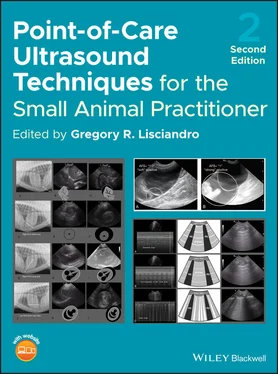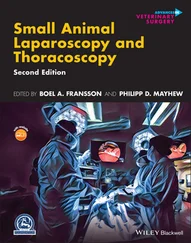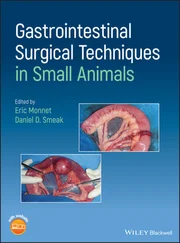Source: (A) courtesy of Dr Gregory Lisciandro, Hill Country Veterinary Specialists and FASTVet.com, Spicewood, TX.
Diffuse hepatic hypoechogenicity (parenchyma is darker than normal due to decreased echogenicity) is generally noted when the hepatic parenchyma is significantly hypoechoic to the renal cortex ( Figure 8.10A,B). In addition, the portal veins are more conspicuous due to the contrast between their hyperechoic walls and the hypoechoic hepatic parenchyma (see Figure 8.10A,B). The portal veins appear as linear “equal signs” ( = ) when evaluating the liver in real time. As a general rule, if they are prominent and numerous against a hypoechoic (dark) background, the liver can be said to be diffusely hypoechoic. Hepatic hypoechogenicity can occur with passive congestion (see Figure 8.10A,B), diffuse inflammatory diseases such as cholangiohepatitis, and diffuse infiltrative diseases such as lymphosarcoma and mast cell disease (see Figures 8.8C,D, 8.10C). Of note, lymphosarcoma can also present with diffuse hyperechoic (brighter) changes or normal echogenicity. Figure 8.10.Diffuse homogeneous hypoechoic and hyperechoic liver. (A) Hepatic venous congestion (veins not shown) with a homogeneously hypoechoic (dark) liver. Note the increase in portal markings (arrows and stippled hepatic echogenicity), analogous to a “starry night.” The portal vein reflections look like stars against the night sky or hyperechoic (bright white) equal (=) signs, depending on the angle of insonation. (B) Hepatic venous congestion with obvious distended hepatic veins (HV) and a homogeneously hypoechoic liver (LIV). The background hepatic echogenicity is an additional example of the “starry night” appearance caused by decreased parenchymal echogenicity and increased conspicuity of the portal markings (<). Notice how the portal vein walls appear as hyperechoic (white) equal (=) signs, and these portal veins are nondistended. Compare to (A). (C) A dog with cholangiohepatitis is an additional example of a disease process that can have homogeneously hypoechoic (dark) liver changes. Note also the inspissated contents of the gallbladder (GB, gallbladder, outlined). (D) Diffusely hyperechoic (bright) liver in a cat diagnosed with hepatic lipidosis. Note that the liver is diffusely hyperechoic (bright) compared to the falciform fat of the near‐field; however, this can be a normal variant in some obese cats (Nicoll et al., 1998). The patient’s clinical picture, and cytological and histopatholgical sampling must be considered for an accurate diagnosis. (E) Image of a patient with chronic active hepatitis (CAH). Note the homogeneously hyperechoic (bright) liver demonstrating the variability of ultrasonographic findings in livers with changes in echogenicity emphasizing the need for fine needle aspiration and/or liver biopsy for definitive diagnosis.
Diffuse hepatic hyperechogenicity (liver is brighter than normal) can be seen with fatty infiltration (hepatic lipidosis in cats), steroid hepatopathy, other metabolic and endocrine hepatopathies (diabetes mellitus), chronic hepatitis and cirrhosis (see Figure 8.10E). In addition to the diffuse hypoechogenicity noted above, infiltrative neoplastic disease such as lymphosarcoma and mast cell tumor can also produce diffuse (homogeneous) hyperechoic changes (see Figure 8.8C,D). Fine needle sampling is a simple and minimally invasive technique for obtaining diagnostic information. If cytology results acquired by fine needle sampling are nonspecific, then a liver biopsy is necessary (percutaneous core biopsy, laparoscopic biopsy or surgical wedge biopsy). Liver biopsies are best in patients in which chronic diffuse hepatic disease is suspected because histopathology is required to evaluate parenchymal architecture. The hepatic parenchyma of cats with hepatic lipidosis is usually hyperechoic to falciform fat. This change can also be an incidental finding in obese cats (Nicoll et al. 1998) (see Figure 8.10D). Liver size is usually increased in cats with hepatic lipidosis, steroid hepatopathy, and infiltrative diseases, and decreased in size in animals with chronic hepatopathies.
Mixed hepatic echogenicity is often associated due to diffuse inflammatory disease (often chronic) or infiltrative disease (neoplasia, fungal infection).
Animals with toxic hepatopathies often have normal hepatic echogenicity (Nyland et al. 2002). Other pathological conditions may also have normal echogenicity and fine needle aspiration and/or biopsy should be considered in the face of a normal ultrasonographic appearance with clinical and biochemical parameters supporting primary liver disease. It is important to remember that animals with severe hepatic dysfunction or diseases may have normal ultrasound findings (Nyland et al. 2002). Additional assessment is indicated when clinical findings support hepatic dysfunction and may include fasting ammonia (NH3) levels, pre‐ and postprandial serum bile acid levels, abdominal CT and, ultimately, liver biopsy.
Pearl: Liver disease cannot be ruled out on the basis of an unremarkable ultrasound examination . Additional evaluation is indicated if clinical findings support liver disease.
The hepatic veins are best evaluated from the right side of the liver where they join the caudal vena cava (see Figures 8.3A,B and 39.3). Moderate to marked dilation of the hepatic veins is usually secondary to right‐sided cardiac insufficiency, including right‐sided volume overload in patients receiving intravenous fluid therapy (see Chapters 7, 20, 26, and 36). Obstruction of the caudal vena cava due to thrombosis, stricture (kinking) or neoplasia can also cause marked distention of the hepatic veins (Kolata et al. 1982; Crowe et al. 1984; Lisciandro et al. 1995; Fine et al. 1998). Hepatic venous distension should be evaluated in conjunction with other clinical signs, and congestion with concurrent ascites (modified transudate) further supports the presence of right‐sided heart failure or obstruction of the hepatic caudal vena cava (see also Chapters 7, 20, 26, and 36).
The gallbladder is easily imaged with ultrasound because it is fluid filled. The gallbladder is generally round to oval; however, it may be bilobed, particularly in cats, and this is generally of no clinical consequence (see Figure 8.4C). Several artifacts are common when scanning the gallbladder, due to its fluid‐filled nature, and the novice sonographer should become familiar with these artifacts in order to minimize misinterpretations. These include acoustic enhancement, side‐lobe artifact, edge shadowing artifact, and mirror image artifact (when the gallbladder contacts the diaphragm–lung interface).
Evaluation of the gallbladder wall is generally easily accomplished due to the contact between the anechoic bile and the more echogenic gallbladder wall and surrounding hepatic parenchyma. The normal gallbladder wall appears as an echogenic (white) line surrounding the luminal contents (see Figure 8.4A–C). Diffuse gallbladder wall thickening may occur with a wide range of conditions such as acute or chronic cholecystitis, hepatitis, canine anaphylaxis (Quantz et al. 2009), right‐sided heart failure, iatrogenic volume overload (Nelson et al. 2010), and hypoalbuminemia (Nyland et al. 2002) (see Chapters 7, 20, 26, and 36). Therefore, the finding must be interpreted in conjunction with additional ultrasound findings as well as clinical signs and biochemical alterations ( Figure 8.11; see also Figures 7.11, 7.12, 18.22, and 39.6).
Generally, gallbladder wall thickening is nonspecific for any of the above conditions and thickening is typically associated with wall edema with similar sonographic features despite the underlying pathologic cause (see Figure 8.11and Table 7.5). Most commonly, the gallbladder wall appears diffusely hypoechoic with parallel hyperechoic lines on either side, referred to as a “double rim effect” or “halo effect” (Nyland et al. 2002; Quantz et al. 2009) (see Figures 7.11, 7.12, 18.22, and 39.6). This change needs to be distinguished from small‐volume fluid external to the gallbladder, where effusion within the gallbladder fossa can mimic the double rim or halo effect. Focal and/or irregular thickening of the gallbladder wall is less common, and may be consistent with chronic cholecystitis or neoplastic change. A flaccid or undulating gallbladder wall may be consistent with wall rupture and warrants correlation to the index of suspicion for biliary peritonitis as well as clinical and biochemical assessment of the patient.
Читать дальше












